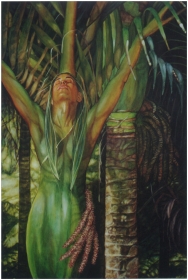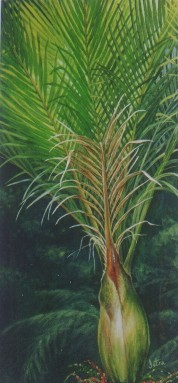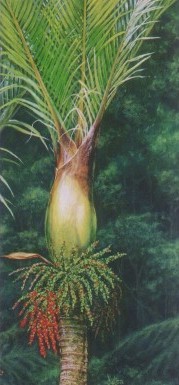 Our
Place in Titirangi
Our
Place in TitirangiNikau palm
Latin name: Rhopalostylis sapida
Rhopalostylis because the style (female flower part) is club shaped; sapida meaning savoury because the expanded central leaf bud was once used for food. However, taking this bud apparently kills the plant.
Maori name: Nikau (many leaves from the same stalk)
Artwork: NIkau Maiden (at right) and the Nikau diptych painted acrylic on canvas by Paula Novak.
This tall, slender and graceful tree with its sensual bulbous curves leading into a spreading latticework of branches is the only native palm in New Zealand.
 The
Nikau is the southernmost palm in the world. It is easy to recognise in
the bush with its circular trunk, ringed with evenly spaced scars from
fallen leaves which are up to 3 metres in length and at their base
circle the trunk completely.
The
Nikau is the southernmost palm in the world. It is easy to recognise in
the bush with its circular trunk, ringed with evenly spaced scars from
fallen leaves which are up to 3 metres in length and at their base
circle the trunk completely.In Spring it sprouts large clusters of mauve flowers which burst from the base of the lowest branch. Initially this is sticky and sweet and attracts insects, in particular bees before it develops to the next stage of producing deep red berries.
The Nikau can grow to 15 metres in height. It thrives in sheltered positions and can be found in coastal and warmer inland forests of the North Island and some parts of the South Island.
The leaf bases are large and
encircle the trunk completely (which is why the leaf scars go right
around the trunk). The number of leaf scars do not tell you how old the
tree is.
The flowers develop under base of the outermost branch and are clearly
visible as a bulge which grows in size until it forces the branch to
disengage. The inflorescence or specialised branching stem bearing the
flowers is then exposed encased in a large pod which quickly falls away.
The spadex (a special sort of inflorescence because it is a fleshy branch) expands and first the male flowers open and later the female flowers. Insects are probably the main pollinators, but nectar eating birds, such as tuis, bellbirds and silvereyes, enjoy the Nikau nectar. Flowers occur throughout the entire year but are most common in spring and summer in Auckland.
The
smallfruits consist of a thin flesh layer over a hard seed and take just
under a year to develop. They are very popular with native pigeons and
other birds, especially in spring or during egg laying because nikau
seed are high in calcium. Itís hard to find any ripe fruit in spring
because the birds eat it as soon as it is ripe.
The Nikau Palm is very
hard to transplant. If the roots are even slightly damaged in the they
will die within a few days
Early Maori
found the palm branches ideal for weaving and thatching the sides of
their houses. The leaves were also woven into baskets and kite bags. The
central, unexpanded, leaf bud (called rito) at the top of the tree was
also very popular with Maori as food, either raw or cooked,
unfortunately it does kill the tree, which is why early settlers called
it millionaire's salad. Young flower buds were also eaten. The leaves
were used to wrap kiore rats and other food prior to cooking in a hangi. 
The pith or
central core of the tree was a slight laxative and was eaten by pregnant
women to relax pelvic muscles. The sap was drunk as a further aid to
ease the labours in childbirth.(4)
References:
(1) Audrey Eagle (1978) Eagle's 100 trees of New Zealand.
(2) Muriel Fisher, E. Satchell & Janet Watkins (1985)
Gardening with New Zealand plants, shrubs & trees.
(3) R.C. Cooper & R.C. Cambie (1991) New Zealand's economic
native plants.
(4) Christina Macdonald (1979) Medicines of the Maori.
(5) Alison Evans & Stephen Barnett (1987) New Zealand in
flower.
(6) Elsdon Best (1977) Forest lore of the Maori.
Content also derived from the following website:
http://www.geocities.com/RainForest/7109/nikau.htm
Ministry of Words, journalist, content creator, performance poet
Host of one of the longest running free content websites in New Zealand
www.wordworx.co.nz and Paula Novak, artist, songwriter, musician
See selections of Paula's art here or go to her website www.istra-artworks.com